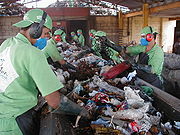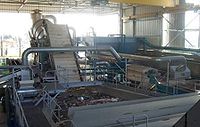
Materials recovery facility
Encyclopedia
A materials recovery facility or materials reclamation facility or materials recycling facility (MRF - pronounced "murf") is a specialized plant that receives, separates and prepares recyclable materials for marketing to end-user manufacturers. Generally, there are two different types: clean and dirty MRFs.
commingled materials that have already been separated at the source from municipal solid waste generated by either residential or commercial sources. There are a variety of clean MRFs. The most common are single stream
where all recyclable material is mixed, or dual stream MRFs, where source-separated recyclables are delivered in a mixed container stream (typically glass, ferrous metal, aluminum and other non-ferrous metals, PET
[No.1] and HDPE
[No.2] plastics) and a mixed paper stream, (including OCC, ONP, OMG, Office packs, junk mail, etc). Material is sorted to specifications, then baled, shredded, crushed, compacted, or otherwise prepared for shipment to market.
 A dirty MRF accepts a mixed solid waste stream and then proceeds to separate out designated recyclable materials through a combination of manual and mechanical sorting. The sorted recyclable materials may undergo further processing required to meet technical specifications established by end-markets while the balance of the mixed waste stream is sent to a disposal facility such as a landfill
A dirty MRF accepts a mixed solid waste stream and then proceeds to separate out designated recyclable materials through a combination of manual and mechanical sorting. The sorted recyclable materials may undergo further processing required to meet technical specifications established by end-markets while the balance of the mixed waste stream is sent to a disposal facility such as a landfill
.
The percentage of residuals (unrecoverable recyclable or non-program materials) from a properly operated clean MRF supported by an effective public outreach and education program should not exceed 10% by weight of the total delivered stream and in many cases it can be significantly below 5%. A dirty MRF recovers between 5% and 45% of the incoming material as recyclables, then the remainder is landfilled or otherwise disposed. A dirty MRF can be capable of higher recovery rates than a clean MRF, since it ensures that 100% of the waste stream is subjected to the sorting process, and can target a greater number of materials for recovery than can usually be accommodated by sorting at the source. However, the dirty MRF process is necessarily labor-intensive, and a facility that accepts mixed solid waste is usually more challenging and more expensive to site.
 New mechanical biological treatment
New mechanical biological treatment
technologies are now beginning to utilise wet MRFs. This combines a dirty MRF with water, which acts to density separate and clean the output streams. It also hydrocrushes and dissolves biodegradable organics in solution to make them suitable for anaerobic digestion
.
was one of "the first materials recovery facilities (MRF) in the US."
Clean MRF
A clean MRF accepts recyclableRecycling
Recycling is processing used materials into new products to prevent waste of potentially useful materials, reduce the consumption of fresh raw materials, reduce energy usage, reduce air pollution and water pollution by reducing the need for "conventional" waste disposal, and lower greenhouse...
commingled materials that have already been separated at the source from municipal solid waste generated by either residential or commercial sources. There are a variety of clean MRFs. The most common are single stream
Single-stream recycling
Single stream recycling refers to a system in which all paper fibers, plastics, metals, and other containers are mixed together in a collection truck, instead of being sorted into separate commodities by the resident and handled separately throughout the collection...
where all recyclable material is mixed, or dual stream MRFs, where source-separated recyclables are delivered in a mixed container stream (typically glass, ferrous metal, aluminum and other non-ferrous metals, PET
Polyethylene terephthalate
Polyethylene terephthalate , commonly abbreviated PET, PETE, or the obsolete PETP or PET-P, is a thermoplastic polymer resin of the polyester family and is used in synthetic fibers; beverage, food and other liquid containers; thermoforming applications; and engineering resins often in combination...
[No.1] and HDPE
High density polyethylene
High-density polyethylene or polyethylene high-density is a polyethylene thermoplastic made from petroleum. It takes 1.75 kilograms of petroleum to make one kilogram of HDPE...
[No.2] plastics) and a mixed paper stream, (including OCC, ONP, OMG, Office packs, junk mail, etc). Material is sorted to specifications, then baled, shredded, crushed, compacted, or otherwise prepared for shipment to market.
Dirty MRF

Landfill
A landfill site , is a site for the disposal of waste materials by burial and is the oldest form of waste treatment...
.
The percentage of residuals (unrecoverable recyclable or non-program materials) from a properly operated clean MRF supported by an effective public outreach and education program should not exceed 10% by weight of the total delivered stream and in many cases it can be significantly below 5%. A dirty MRF recovers between 5% and 45% of the incoming material as recyclables, then the remainder is landfilled or otherwise disposed. A dirty MRF can be capable of higher recovery rates than a clean MRF, since it ensures that 100% of the waste stream is subjected to the sorting process, and can target a greater number of materials for recovery than can usually be accommodated by sorting at the source. However, the dirty MRF process is necessarily labor-intensive, and a facility that accepts mixed solid waste is usually more challenging and more expensive to site.
Wet MRF

Mechanical biological treatment
A mechanical biological treatment system is a type of waste processing facility that combines a sorting facility with a form of biological treatment such as composting or anaerobic digestion...
technologies are now beginning to utilise wet MRFs. This combines a dirty MRF with water, which acts to density separate and clean the output streams. It also hydrocrushes and dissolves biodegradable organics in solution to make them suitable for anaerobic digestion
Anaerobic digestion
Anaerobic digestion is a series of processes in which microorganisms break down biodegradable material in the absence of oxygen. It is used for industrial or domestic purposes to manage waste and/or to release energy....
.
History
In the United States, modern MRF's began in the 1970s. Resource Recovery Systems, Inc. operated by Peter KarterPeter Karter
Peter Karter was an American nuclear engineer and one of the pioneers of the modern recycling industry. He lived in Old Lyme, Connecticut....
was one of "the first materials recovery facilities (MRF) in the US."
See also
- Curbside collection
- List of waste treatment technologies
- Mechanical biological treatmentMechanical biological treatmentA mechanical biological treatment system is a type of waste processing facility that combines a sorting facility with a form of biological treatment such as composting or anaerobic digestion...
External links
- Diagram of MRF process
- Typical commercial recycling plant with information about recycling methods
- "Coming soon! van der Linde's amazing recycling machine"
- Materials Recovery Facility: Description of the MRF in the Context of its role as one of the component parts of Mechanical Biological Treatment (MBT) processes

